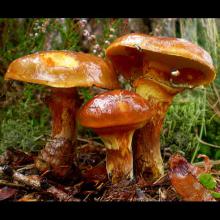Suillus grevillei
Common name:
Greville's bolete
Genus:
Suillus
Family:
Suillaceae
Order:
Boletales
Suillus grevillei
Common name:
Greville's bolete
Genus:
Suillus
Family:
Suillaceae
Order:
Boletales
Suillus grevillei
Common name:
Greville's bolete
Genus:
Suillus
Family:
Suillaceae
Order:
Boletales
Genus (Fungi): Suillus
Suillus is a genus of basidiomycete fungi in the family Suillaceae and order Boletales. Species in the genus are associated with trees in the pine family (Pinaceae), and are mostly distributed in temperate locations in the Northern Hemisphere, although some species have been introduced to the Southern Hemisphere.
Description
Structures of the fungi in this genus in common with other members of the order Boletales include the presence of a cylindrical stipe, cap, soft flesh and tubular hymenium. Specific characteristics common to most species in Suillus are the cap cuticle which is often slimy and sticky when moist, the presence of darkly staining, clustered, sterile cells called cystidia that give the tube mouths or the stipe surface a speckled or glandular appearance, spores that are usually cinnamon brown or chocolate brown in mass, and obligate mycorrhizal relationships primarily with members of the Pinaceae, especially with members of the genera Pinus, Larix and Pseudotsuga.
Intra-genus variation may be demonstrated by differences in color and ornamentation of the cap cuticle, flesh, pores and stipe, the presence of a partial veil in immature forms and annuli thereafter, pore shape and distribution, as well as habitat. The cap cuticle is dark brown in S. brevipes, and yellow in S. grevillei. S. granulatus has a smooth cap cuticle, while that of S. lakei is finely scaly. The pores are bright yellow in S. collinitus, cinnamon in S. variegatus and grey in S. viscidus; in shape they are round in S. luteus and angular in S. bovinus. The flesh is white to yellow in S. luteus, while it is pallid in S. variegatus with a tendency to turn blue when exposed to air. Young S. luteus and S. grevillei bear partial veils whose remnants remain as annuli hanging from the stipe; in S. granulatus the stipe is bare. S. viscidus and S. grevillei occur under larch (Larix) only, while S. sibiricus is restricted to a few species of 5-needled pine (Pinus).
Reference: Wikipedia

